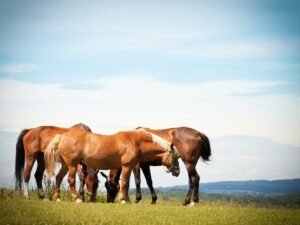The most popular horse pasture in tropical and sub-tropical Australia has been, since horse pasture has been bothered to be thought about, the African native Rhodes grass.
Horses being an introduced species, there wasn’t a naturally occurring Australian grass that quite gave the full gamut of goodness that horses want and need.
Callide Rhodes grass was the answer, and was brought in as an introduced species at the start of the 20th century. Previous attempts to get European feeds to take off in Australian conditions were horribly unsuccessful, and new Australians were desperately searching for pastures that would both grow and meet their horses’ needs. The African origins helped the grass cope with the desert-through-tropical variety of conditions that were so foreign to the early European settlers and their horses.
Ever since, Callide Rhodes has been the go-to option for northern Australian pastures. And for good reason.
Pros
Callide Rhodes, as with other Rhodes varieties that have been since developed to fill other niches, have a terrific mix of vitamins and minerals that give your horses the best chance of being healthy and happy. The key feature is the low oxalate/high calcium combination that, unlike most other pasture grasses, allows the horse to get a healthy dose of calcium.
Callide Rhodes is a tough grass when in its preferred conditions. The roots stretch down as far as 4.5m, meaning that it is able to stand up to heavy grazing without being ripped out, and able to outlast both a lengthy dry spell and temporary flooding.
Cons
Being a subtropical grass, Callide Rhodes is fairly susceptible to cold conditions. The ideal growing temperature for the grass sits between 20-37C, and it will grow dormant and eventually die off the further beneath 20C the mercury gets. If you reside in an area that has any sort of predisposition to frosts, it would be wise to look at another grass.
The other weakness in Callide Rhodes is its aversion to saline soils. If you have naturally saline soil or have irrigated yourself into a salty position, Callide will struggle to take.
Establishment
To get the optimum germination from your seed, you want to sow Callide Rhodes when you’re sure to get a good soaking of rain. For the northern parts of Australia to which it’s best suited, this could be anywhere between September and March. Like most subtropical grasses, sowing earlier in this period – around the start of the wet season – is usually considered best, as you’ll have all the rest of the wet season’s rains to capitalise on.
When sowing, the ideal seedbed is one that is both fine grained and firm. The seeds can be sown on top of the soil, or planted just below the surface (less than 2cm deep). The seed will lay dormant until there is sufficient water for germination.
Although Callide Rhodes can be cultivated by itself as a monoculture, it has been found to perform even better when planted in tandem with other sub-tropical grasses. This has been shown to increase pasture production and result in better quality pasture in the long run.
Notes
When first planting Callide Rhodes, you want to allow it a period of time to really anchor its roots into the ground without being disturbed. It’s recommended that you give the grass up to a year to set itself before grazing. 8-12 months should be enough time for it to get the root system nice and deep, and will hopefully give it a good period of establishing rain to help it along.
Flowering lowers the feeding value of Callide quite dramatically. Once set, you need to keep an eye on your grass, cutting, slashing or grazing it back to keep it at its most nutritious for your stable.
If you’re wondering whether Callide Rhodes Grass will suit your pasture needs, consult your local McKays seed specialist.


